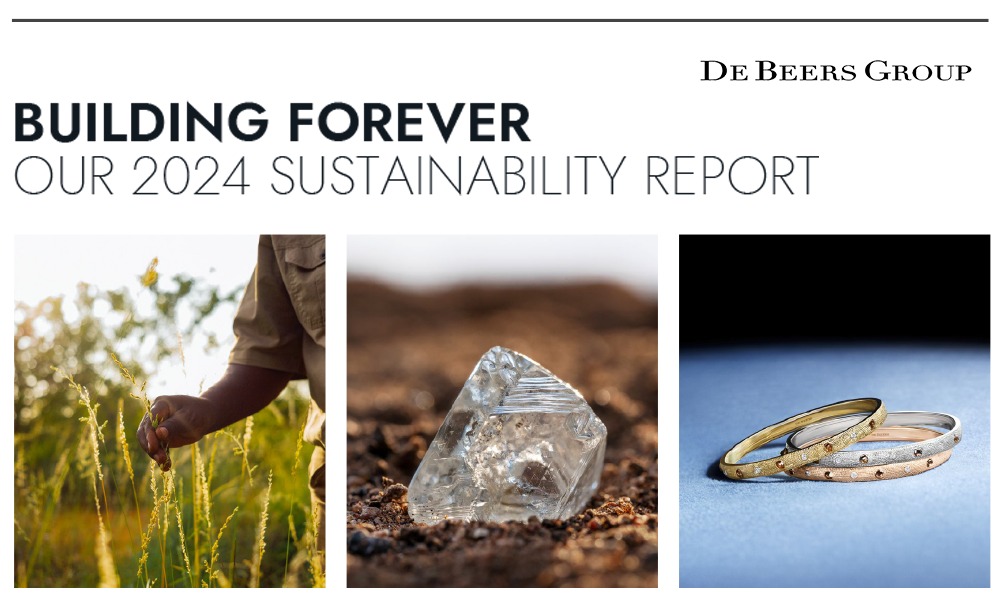JB Insights
De Beers Group delivers progress with sustainability and provenance initiatives, supporting enhanced confidence in De Beers-sourced diamonds
De Beers, believes a diamond’s journey should be as meaningful as its beauty. That’s why sustainability is embedded in everything they do – from developing renewable energy in our partner countries to advancing gender equity and supporting long-term national development.

De Beers Group today published its 2024 sustainability report, highlighting significant progress across its key focus areas of climate, livelihoods, nature and provenance. These areas were identified as the priorities for De Beers Group’s sustainability work as part of a mid-term review of the Group’s Building Forever sustainability framework initiated last year.
During the course of 2024, De Beers Group made meaningful progress in areas including emissions, safety and conservation. In addition, the business has substantially advanced its work on diamond provenance and traceability, with the blockchain-backed Tracr platform enhancing its effectiveness and scale.
With regards to its focus on climate, De Beers Group has reduced its Scope 1 and 2 emissions by 7% since 2021. The Group focused on developing renewable energy solutions in 2024, working with Envusa Energy to complete the financing of wind and solar plants in South Africa which will meet 100% of the mine’s electricity needs in 2026. De Beers Group also continued the development of the Mmadinare solar PV project in Botswana, completed its Electrification and Alternative Fuels study at Venetia, and launched alternative fuels studies at Debswana, Namdeb and Debmarine Namibia. Moreover, De Beers Group worked with its top 100 strategic partners to develop roadmaps to reduce Scope 3 emissions. De Beers Group has had its near-term emissions reduction targets validated by the Science Based Targets initiative (SBTi) and has committed to reducing absolute Scope 1 and 2 GHG emissions by 42%, and Scope 3 by 25% by 2030 (from a 2021 base year).
From a livelihoods perspective, De Beers Group made a total tax and economic contribution of $2.9bn in 2024, highlighting the socioeconomic value that responsibly sourced natural diamonds deliver. The Group also achieved its best ever safety performance, with a total recordable injury frequency rate (TRIFR) of 1.2.
Several high-impact programmes continued to drive meaningful change in host countries. Through the EntrepenHER programme, delivered in partnership with UN Women, around 500 more women were supported and the programme expanded to reach 1,500 more female entrepreneurs over the next three years, bringing the total number of women reached to more than 3,100. The Stanford SEED programme, run in collaboration with the Stanford Graduate School of Business, continued to support entrepreneurs across southern Africa and has helped create 3,400 jobs since its launch in 2018. Meanwhile, the GirlEng programme continued in partnership with WomEng and has now supported over 6,500 girls with a focus on STEM subjects since 2019.
In addition, De Beers Group developed a new 10-year Diamonds for Development Fund as part of its engagements with the Government of the Republic of Botswana for a new Debswana Sales Agreement and Mining Licences.
With respect to nature, De Beers Group managed over 375,000 acres of land for conservation purposes in 2024, ensuring the maintenance of the habitat for a range of endangered, vulnerable and threatened species. The Group relocated 10 white rhino from Botswana to South Africa as part of a rewilding project, and through the Namdeb- Debmarine Foundation partnered with conservation stakeholders to design a seabird rescue facility in Luderitz, Namibia to help prevent the extinction of the African Penguin. Furthermore, De Beers Group continued to partner with National Geographic to protect the source waters of the Okavango Delta through the Okavango Eternal programme.
Alongside the progress made with the sustainability pillars of climate, livelihoods and nature, De Beers Group delivered transformational progress with its work on provenance, advancing and scaling the Tracr blockchain platform in 2024. Nearly three million individual diamonds have been registered on the platform since 2022, with leading producers and suppliers joining the platform, including ODC and Mountain Province, thereby increasing the volume of diamonds on the platform being registered at source. Tracr has also begun providing country of origin information for all De Beers Group-sourced rough diamonds over one carat registered on the platform. In addition, Tracr is undertaking both rough-to-rough and rough-to-polished objective verification of diamonds on the platform, enhancing the levels of assurance it provides throughout the value chain.
Building on the progress delivered with sustainability and provenance, De Beers Group continues to develop consumer propositions that enable people to buy natural diamonds with assurance on their country of origin and impact on the people and places where they are discovered. This includes the launch of a new polished diamond programme called ORIGIN – De Beers Group. In recognition of the growing consumer interest in where a product has come from and the impact it has had along its journey, ORIGIN – De Beers Group enables participating retailers to access polished diamonds that have been sourced by De Beers Group, tracked through the value chain by the Tracr blockchain platform, and accompanied with rich information about each diamond’s unique journey and the meaningful impact it has delivered.
Sandrine Conseiller, CEO of Brands & Diamond Desirability at De Beers Group, said: “At De Beers, we believe a diamond’s journey should be as meaningful as its beauty. That’s why sustainability is embedded in everything we do – from developing renewable energy in our partner countries to advancing gender equity and supporting long-term national development. We’re not just powering our operations sustainably; we’re helping build infrastructure that benefits communities. We’re not just creating opportunities for women within our business; we’re unlocking potential for female students and entrepreneurs across our host nations. And through our enduring partnership with Botswana, we’re securing the future of our supply while investing in the country’s economic development and diversification. Thanks to our provenance platforms like Tracr and the consumer-facing experiences we’re building, we can share these stories with confidence.

JB Insights
WGC REPORT: India gold market update: Seasonal strength

Highlights
- Gold prices soften from record highs yet remain supported
- Domestic prices slide back into discount
- Gold demand, led by investment buying, strengthened during the festive period, but softened thereafter
- Gold ETFs continue strong momentum in October with record inflows and new investors
- Gold imports soar in October, despite the price rally
Looking ahead
- The busy wedding season over the coming months (November–March), with a high number of anticipated weddings, is expected to support jewellery demand.
- Investment interest in gold is likely to persist amid broadly bullish sentiment around gold.
Prices retreat from peak, but maintain firm trend

International gold price1 recorded a sharp rally in October, hitting its 50th record high of the year during the month. Although price eased by about 7% from the peak, it still ended October 5% higher at US$4,011.5/oz. The momentum carried into November, with price up nearly 3% m-t-d as of 19 November. This sustained performance has lifted gold’s y-t-d gains to 58%.
Our Gold Return Attribution Model (GRAM) suggests that recent movements in international gold prices have been driven by geopolitical risk, higher implied volatility, a stronger US dollar, as well as momentum and evolving interest-rate expectations.
Domestic gold prices have largely tracked the international trend but have delivered even stronger returns, recording 63% y-t-d growth. The higher domestic gains are attributed to the 3.3% depreciation of the Indian rupee. Domestic gold prices, which had mostly traded at par with, or at a premium to, the international price over the past two months, shifted to a discount following the peak festive demand period (Chart 2), with the m-t-d2 discount averaging US$18/oz.
Festive demand shines, tapers after

Festive demand around Diwali and Dhanteras3 – India’s peak gold-buying occasions – was reportedly strong despite record-high prices, according to feedback from industry stakeholders. Market participants consistently highlighted that the strength was driven primarily by investment-oriented buying, particularly bars and coins, with some noting volume nearly doubling from a year ago. E-commerce platforms also saw solid sales,4 and digital gold purchases rose too. Unified Payments Interface (UPI) data shows digital gold purchases increasing 62% m/m to INR22bn (US$259mn) in October.5 In tonnage terms, the volume rose 45% m/m to 1.8t.
Jewellery sales also held up well during the festive period, with retailers reporting healthy sales across both single-store and large multi-store formats, the latter benefitting from brand trust and promotional initiatives. Although jewellery volumes were softer due to elevated prices, the overall value of sales remained healthy, reportedly up by around a quarter y/y for many, reflecting resilient festive buying sentiment.
Post-Diwali, demand has reportedly softened. Industry feedback suggests market activity in November has been subdued, despite the onset of the wedding season. Jewellery buying is largely wedding-driven, while investment demand persists. Supply of old gold into the market has reportedly moderated. Trade participants attribute this to consumers having exhausted surplus gold for immediate needs and now choosing to hold onto jewellery in expectation of further price gains. Jewellers remain cautiously optimistic that the ongoing wedding season (November–March) will boost jewellery sales, given the expected large number of weddings.
ETFs: persistent strong inflows

October marked the sixth consecutive month of strong inflows into Indian gold ETFs, emphasising the growing appeal of gold as an investment asset in various forms.
Net inflows for the month were INR77bn (US$876mn), a modest 8% decline from the previous month, largely in line with our estimates.7 Despite this moderation, the figure remained significantly higher than the y-t-d average of INR28bn (US$315mn). The dip was primarily due to a sharp rise in redemptions, which hit a record INR21bn (US$244mn). This surge in redemptions was likely driven by profit-taking following the rally in gold prices. Gross inflows for the month, however, set a record at INR99bn (US$11bn). The exceptional rise in gold prices likely drew investor attention, contributing to the strong inflows, while ongoing safe-haven demand further reinforced this trend. Net inflows have continued into November, reaching INR24bn (US$269mn) during the first 17 days of the month.8
The first 10 months of 2025 have been particularly strong for gold ETFs, with cumulative inflows totalling INR276bn (US$3.1bn) – the highest annual inflows on record. This surpasses the total inflows from March 2020 to December 2024. This unprecedented demand has propelled the assets of these funds to historic levels. As per AMFI data, as of end October, the assets under management (AUM) of gold ETFs climbed to a record INR1,021bn (US$11.5bn) and gold holdings rose to 83.5t,9 nearly a third of which were added in 2025 alone.
The growing interest in gold ETFs was further evidenced by the increase in new investors. In October, a record 911,000 new accounts (folios) were added, bringing the total number of folios to 9.57mn, reflecting a 49% increase y-t-d.
In addition to the strong performance of existing gold ETFs, the market saw the launch of a new gold ETF in October,10 bringing the total number of gold ETFs in India to 23.
Imports surge to new peak in October despite price rally
Gold imports registered a sharp surge in October, marking the fourth consecutive month of growth in both value and volume terms. Notably, the increase occurred despite domestic gold prices touching record highs – rising 60% y/y and 11% m/m11 – indicating resilient domestic demand. In value terms, imports climbed to US$14.7bn, the highest on record, translating into a ~200% y/y and 53% m/m increase. Import volumes also rose substantially, with inflows estimated at 137–142t, compared with 102t in September and 61t a year earlier. The October surge was largely driven by seasonal factors, i.e. the Diwali festivities and the onset of the wedding season.
On a y-t-d basis, gold imports have totalled US$51bn, an increase of 16% y/y. In contrast, the import volumes, estimated at around 559t, are down 12% from a year ago, reflecting the impact of elevated gold prices.
-

 BrandBuzz2 weeks ago
BrandBuzz2 weeks agoIndriya unveils Rajashree, the Bridal Collection of Maharashtra
-

 National News18 hours ago
National News18 hours agoBengaluru-based lab-grown diamond jewellery startup ONYA raises ₹5.5 crore in pre-seed funding led by Zeropearl VC
-

 International News14 hours ago
International News14 hours agoDMCC Launches ‘DMCC FinX’ To bridge institutional capital, trade and technology
-

 International News16 hours ago
International News16 hours agoGJEPC organises 22nd consecutive ‘India Pavilion’ at Jewellery Arabia in Bahrain







